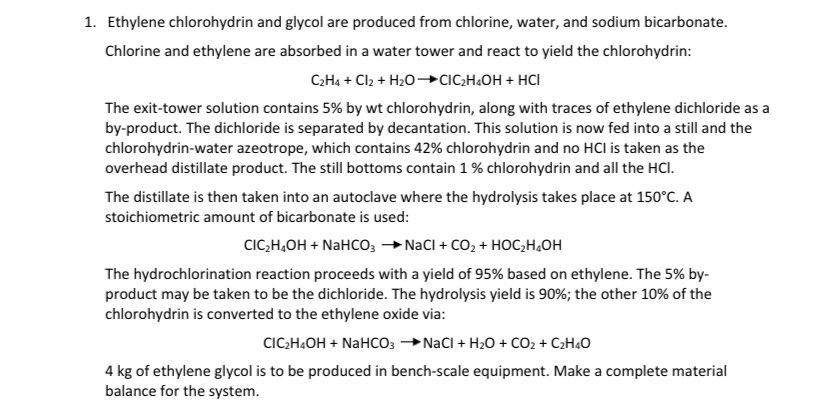Home /
Expert Answers /
Chemical Engineering /
ethylene-chlorohydrin-and-glycol-are-produced-from-chlorine-water-and-sodiu-pa742
(Solved): Ethylene chlorohydrin and glycol are produced from chlorine, water, and sodiu ...

Ethylene chlorohydrin and glycol are produced from chlorine, water, and sodium bicarbonate. Chlorine and ethylene are absorbed in a water tower and react to yield the chlorohydrin: \[ \mathrm{C}_{2} \mathrm{H}_{4}+\mathrm{Cl}_{2}+\mathrm{H}_{2} \mathrm{O} \rightarrow \mathrm{ClC}_{2} \mathrm{H}_{4} \mathrm{OH}+\mathrm{HCl} \] The exit-tower solution contains \( 5 \% \) by wt chlorohydrin, along with traces of ethylene dichloride as a by-product. The dichloride is separated by decantation. This solution is now fed into a still and the chlorohydrin-water azeotrope, which contains \( 42 \% \) chlorohydrin and no \( \mathrm{HCl} \) is taken as the overhead distillate product. The still bottoms contain \( 1 \% \) chlorohydrin and all the \( \mathrm{HCl} \). The distillate is then taken into an autoclave where the hydrolysis takes place at \( 150^{\circ} \mathrm{C} \). \( \mathrm{A} \) stoichiometric amount of bicarbonate is used: \[ \mathrm{ClC}_{2} \mathrm{H}_{4} \mathrm{OH}+\mathrm{NaHCO}_{3} \rightarrow \mathrm{NaCl}+\mathrm{CO}_{2}+\mathrm{HOC}_{2} \mathrm{H}_{4} \mathrm{OH} \] The hydrochlorination reaction proceeds with a yield of \( 95 \% \) based on ethylene. The \( 5 \% \) byproduct may be taken to be the dichloride. The hydrolysis yield is \( 90 \% \); the other \( 10 \% \) of the chlorohydrin is converted to the ethylene oxide via: \[ \mathrm{ClC}_{2} \mathrm{H}_{4} \mathrm{OH}+\mathrm{NaHCO}_{3} \rightarrow \mathrm{NaCl}+\mathrm{H}_{2} \mathrm{O}+\mathrm{CO}_{2}+\mathrm{C}_{2} \mathrm{H}_{4} \mathrm{O} \] \( 4 \mathrm{~kg} \) of ethylene glycol is to be produced in bench-scale equipment. Make a complete material balance for the system.